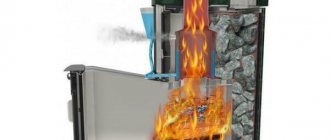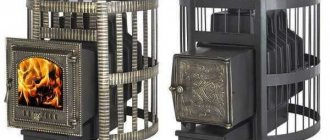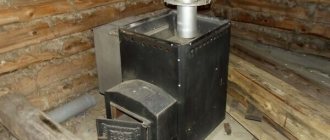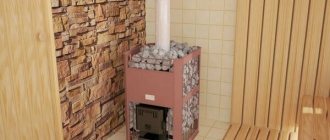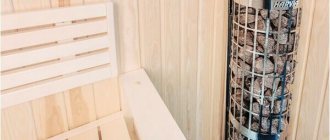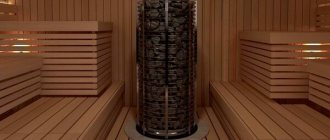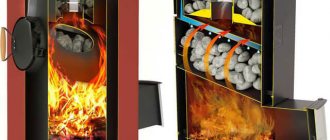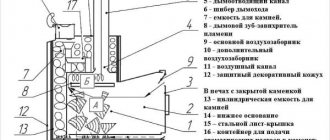Feringer stoves are recognized by experts and connoisseurs of baths as one of the best. They are available in several versions and have two categories:
- Ovens with a closed heater to create the atmosphere of a Russian steam room (temperature 55-70°C, humidity 40-75%). In the catalog they are located in the “Steam ovens” section.
- Stoves with an open heater for dry-air saunas (temperature from 80° and low humidity 10-15%). They can be found in the “Golden Ratio” section.
- Not so long ago, in 2011, a third line appeared - “Lamelle”. It is distinguished by the presence of a cladding made of natural stone, and some changes have been made to the design of the stove, allowing you to confidently heat steam rooms in log houses from sub-zero temperatures.
The stone fastening system of the new stoves is interesting: a holder with hooks is mounted on a stone cut into plates. These hooks are used to fix the stone slats in a special groove. The system is simple but effective, and installation is very easy and takes less than an hour.
This is what the new Feringer Lamel oven looks like
Let's start with the line of Feringer stoves.
Stoves are divided into 2 main types - stone and metal stoves. Metal stoves are suitable for budget stoves, but if you want to feel the full effect of a Russian bath, there is only one way out - stone. Stone cladding completely eliminates infrared radiation. From personal experience I will say that when the stove is running for about 40 minutes, you can still lean your hand against the lining. Yes, hot, but tolerable temperature.
Thanks to the stone lining, accidental burns cannot be caused by this stove. No safety rail required!
The only downside is the price. A stone-clad stove with the cheapest stone (coil) costs on average three times more.
Metal stoves are made from exactly the same metal and thickness, everything is the same, except for the absence of stone. Great respect to the founder of the company that he does not skimp on budget stoves, but produces such high-quality ones from metal and stone.
There are three power options:
- Baby/Mini (8-16 m3)
- Classic/Optima (8-23 m3)
- Harmony/Maxi (12-30 m3)
TOP 4 best models
Feringer stoves are always popular among lovers of Russian baths. The following models received the best reviews.
MINI
The model is designed for steam rooms with a volume of up to 16 cubic meters. The combustion chamber is made of heat-resistant stainless steel, the door is equipped with a viewing glass.
The MINI model can be used in rooms with a volume of up to 16 cubic meters. Its design includes a phytocontainer for aromatherapy and a steam gun, which will help make your sauna experience feel like visiting a spa salon.
Advantages of the model:
- minimum convection in the oven;
- stylish design;
- creates good steam.
- The disadvantages include the need to select a certain size of firewood: shorter than standard ones.
OPTIMA
Stylish stove, released in 2022. The model is suitable for a steam room that needs to be equipped in the form of a Russian bath. The volume of the room should be no more than 18 cubic meters.
The heater type in the model is closed. It can hold up to 100 kg. The stove unit is installed “through the wall”, that is, the heater is located in the room, and the remote portal is in the next room.
Advantages of the model:
- possibility of facing with 10 types of stones;
- installation using the “through the wall” method.
- The disadvantage is the high cost.
MAXI
The large Feringer oven is designed not only for cleaning, but also to make you feel light and calm. The unit is designed for rooms up to 30 cubic meters. The buyer has the opportunity to choose one of 10 colors of stone for cladding the equipment.
Advantages of the model:
- steam gun and phytocontainer included;
- saving on fuel;
- modern and reliable design solutions.
- The only drawback is the high price.
DOBRYNYA
The model is suitable for steam rooms with a volume of up to 13 cubic meters. The oven is easy to maintain and is equipped with a reliable convector. The remote tunnel is covered with a special casing. A water container is mounted in the upper part.
The Dobrynya stove allows you to create the necessary heating in a room with a volume of up to 22 cubic meters. It is considered very effective for steam rooms with wet hot steam. The stove is absolutely safe to use, durable and reliable.
Advice! It is recommended to line the sides of the Dobrynya stove body with bricks.
Closed heater in Feringer ovens.
As you could see in the Vesuvius (Hurricane) or TMF (Geyser) stoves, manufacturers mainly make an open heater and a small closed one inside it. Feringer took a different path. This stove is a completely closed heater, and its main task is to heat the stone as much as possible. The stone completely envelops the firebox. In the Feringer furnace at the factory, the stone was heated to 600 degrees! At the moment I have not yet seen results, in indirect heating ovens, greater than that of Fehringer.
We all know very well that for a Russian (steam) stove the main task is to heat the stone. With an open heater you will never get this effect.
First firebox and subsequent operation
The first fire of a fully finished stove with stones placed in the heater must be done in active mode so that the fireplace and the stones warm up. Then let it cool slowly.
Attention! During the first fire, it is strictly forbidden to supply water to the PiF. This is necessary to relieve stress in the nodes after welding. At temperatures of zero degrees and below, the presence of water in the PIF housing must not be allowed to avoid deformation, damage and leakage.
Using mutual funds
In order for the steam evaporator to work correctly, it is important to follow the instructions:
- Open the distribution valve, pour water into the PiF. Add in portions of 50-100 ml. at short intervals of 10–15 minutes in a heated PIF will speed up the warming up of the steam room, which is especially important in the cold season.
- PiF, heated by flue gases from 300 degrees with a noise effect, evaporates water. The steam mixes with air, forming a steam-air mixture, is heated from the chimney and exits into the steam room, further heating the room.
- Pouring water in a large volume of 1–1.5 liters will speed up the heating and humidification of the steam room. The water in the container boils and steam comes out through the exhaust channel with a temperature of up to 150 degrees, then the steam mixes with air, forming a steam-air mixture, is heated from the chimney pipe and exits into the steam room, heating and humidifying the room.
- After heating the stones to 300-500 degrees, close the steam distribution valve and pour 1-1.5 liters of water into the PIF. The resulting steam, passing through the heater, overheats and, forming a steam-air mixture, enters the steam room. This will create the conditions for a pleasant procedure. Water can be refilled.
Important! During operation, it is prohibited to install devices at the outlet of the steam evaporator that prevent the free exit of steam.
There is no grate in the Feringer oven!
Guys, when I first saw this stove, my surprise knew no bounds. The stove has no grate! How is that???
And like this) It turns out that such a stove has advantages compared to grate stoves. The photo shows how firewood is loaded. The largest ones are at the bottom, the medium ones are in the middle, and at the top there are wood chips and small firewood for heating. The fire, with such combustion, immediately begins to warm the stones and evenly goes down to the bottom. There is also a big saving in firewood. Feringer stoves, starting with the classics, are stoves of the same type. Those. no need to throw it up. One tab is designed for the entire vaping cycle.
When the wood begins to burn out, it is necessary to open the lower vent and close the upper valve. Thanks to this fraud, the coals from the firewood will burn out completely and, if the quality of the firewood is good, only ash will remain.
Feringer furnaces - the eternal shine of pure glass.
Feringer ovens
The photo shows a new cozy stove, we’ll talk about it in this article.
Design features
The first thing that catches your eye is the elongated shape and a rather voluminous firebox. Moreover, if you look at the Feringer sauna stove in a horizontal section, it turns out that the firebox is surrounded by stones on almost all sides. And the heat from the wall of the firebox is transferred to the stones, from them the screen is already heated, and then the room is heated by radiant heat from the screen. Therefore, there is no need to cover this metal stove with a brick screen, as is done when installing the vast majority of other models (the exception is the Kutkin stove).
Feringer furnace section
Another feature is the firebox without grates. This is because the top combustion principle is used. With this option, the firewood is lit not from below, as we are used to, but from above. This principle makes it possible to use the heat from burning wood to the maximum. In this position, the coals are constantly in the combustion zone. As a result, there are almost no unburned residues. If there are a few coals left, then only those that burned last.
The next design feature is the presence of a smoke tooth and a side combustion system. They also ensure that more heat goes to warming up the heater rather than escaping into the chimney. The side burning system is a special design in the firebox in which the coals do not lie in the center, but are scattered throughout the stack, igniting the wood lying on the side. After all, in wood-burning stoves this is the zone that burns the worst. In Feringer stoves, the entire surface of the wood burns.
The smoke tooth, located in the upper part of the firebox, twists the flame at the top in a spiral (look at the photo). In this way, the flame stays in the firebox longer, heating up the walls more strongly, and small remnants of it end up in the pipe. But the heat that inevitably ends up in the chimney can be used to heat the steam room. For this, Fehringer has several solutions:
- A heater on a pipe in a traditional and non-traditional design: with a mesh or a decorative carved screen.
- Controlled convector on a pipe. This is a device with a duct system around a main metal pipe.
Diagram of air movement during furnace operation
When installing a controlled convector at its very bottom, immediately after the stove is lit, boiling water is poured. As flue gases pass through, water turns into steam and enters specially formed lamella channels. Since moist air (steam) has a large heat capacity, passing along the wall, it takes away and transfers more heat. These flows contribute to faster heating of the steam room. But this device should only work during the warm-up stage. When they start steaming, it is closed (by turning the damper). By this time, all the water in the convector should have boiled away.
How is a clean glass system achieved?
There are several options:
- A gap, valve or other air flow above the glass. Due to this, the “cold” air that penetrates through the inlet flows down the glass. Due to this, it cuts off all smoke and flames from the glass;
- The glass does not fit very tightly in the frame. The glass, due to the negative pressure in the combustion chamber, is pressed away from the frame to allow air to penetrate. And the air begins to work according to the first principle.
- There is an option when the valve is lower than the glass, but in most cases this option does not work.
Feringer works on the first principle. Thanks to this, the glass is always clean. The principle itself is as old as the world. It is often used in fireplaces. Here is a video of the oven in operation:
View this post on Instagram
A Feringer stove in action. It burns very beautifully! #stove #stove for baths #bath #sauna #steam room #steam room #for baths #for saunas #beauty #fire #fire #sauna
A post shared by HozYain (@hozyain_s) on Aug 22, 2022 at 6:56am PDT
But! If you don’t read the instructions, you get this option:
What about iron?
The furnaces use high-alloy stainless steel AISI 430. Due to this, their service life is very long. Clients come in whose ovens last 10-12 years. And this is during normal use, not once every few months.
The firebox is reinforced with stiffening ribs. The firebox may deform over time, but only slightly. This does not affect the work.
Installation rules
Installation of the stove and smoke ducts must be carried out by qualified employees of a specialized construction and installation organization. If you decide to do it yourself, it is important to follow the recommendations and technology.
Housing installation
The furnace is installed on a refractory base with a height of 150 mm. If the floor in the room is wooden, to protect it from fire, it is covered with two layers of brickwork with clay mortar. Between the floor and the bricks there must be a layer of basalt cardboard with a thickness of at least 10 mm. The size of the base or brick platform should protrude beyond the dimensions of the stove at the back and side by 100 mm, and at the front by 500 mm.
The distance from the stove to the wall made of combustible materials must be at least 500 mm. They can be reduced to 200 mm if there is protection with a metal sheet over a 10 mm thick layer of basalt cardboard or brickwork. The protection height is at least 700 mm from the top of the stove. The distance from the oven door to the opposite wall must be at least 1250 mm.
The section of the ceiling above the stove and connecting pipe must be made of non-combustible materials. The combustible ceiling is covered with a metal sheet over a layer of fireproof insulation with an area exceeding 1/3 the area occupied by the stove, while the overall dimensions of the insulation must be at least 300 mm larger than the plan dimensions of the stove.
If the furnace is located on the border of two rooms, the partition for installing the tunnel must be made of non-combustible materials. It is best to use brick to a height of at least 1600 mm. To prevent thermal deformation of the brick, basalt cardboard with a thickness of 10 mm and a basalt slab with a thickness of 40 mm must be laid between the tunnel and the masonry.
The wall on the stove side must be protected by a fireproof metal sheet with a thickness of 0.5 mm, a width exceeding the width of the stove itself by at least 200 mm on each side and a height to the ceiling. The floor in front of the firebox must be protected with a metal sheet measuring at least 700x500 mm.
To install the stove “through the wall,” make or pre-design a hole in the wall with dimensions such that there is free space around the tunnel, approximately 40-50 mm.
Unscrew the self-tapping screws on the front panel and remove the stove facade with the shelf. Install the stove in the steam room on a prepared base with a tunnel into the wall. Seal the space between the tunnel and the wall with fire-resistant mineral wool. Install and secure the portal.
Important! If in the future you plan to install a decorative portal in natural stone cladding, provide an additional gap between the stove body and the wall to avoid additional costs.
Installation of mutual funds
When installing the steam evaporator, proceed as follows:
- Install the PiF on the top surface of the firebox, and the starting pipe on it.
- Fill the heater. Place the stones in a cold oven, preferably at an angle of 60 degrees.
- Install a base plate on the stove with a built-in installation for distributing water supply to the stones and P&F.
- Water is poured into the PiF through a water supply container oriented into the middle channel of the built-in water supply system in the support plate.
- Install a water supply container.
Let's summarize.
Pros:
- The oven heats the stone as much as possible, so you get light steam;
- Good quality high alloy stainless steel. Ovens last a very long time!
- The vortex system increases the efficiency of the oven.
- One bookmark stove. No need to be a fireman while your friends are relaxing :)
- You will not get burned from the outer walls of the oven.
- Stone stoves.
- Budget design in metal, but not inferior in quality to the premium series.
- Clean glass system.
Of the minuses:
- You have to get used to it and read the swearing part. The stove is easy to use, but different from ordinary ones. Because of this, you need to get used to it a little.
